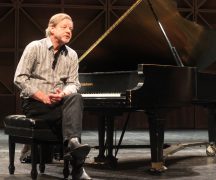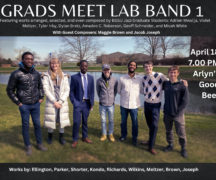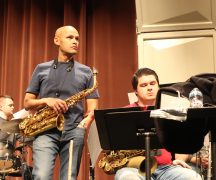By DAVID DUPONT
BG Independent News
“In the Face of Chaos” is jazz composer and saxophonist David Bixler’s first recording in five years. Issued on Friday on Red Piano Records, the session was a decade of turmoil in the making.
Bixler, director of Jazz Studies at Bowling Green State University, mentions the troubles that shaped the music in the recording’s liner notes. Sean, the youngest of his and Heather Martin Bixler’s four children, suffers from severe and baffling neurological problems. That, he writes, “necessitated a shift in my priorities for much of the last decade — a period in which my family devoted much of its energy to the circumstances and needs of the youngest member.”
His son’s health issues coincided with Bixler’s arrival at BGSU in 2008.
For Bixler, and his wife, who is a professional violinist, this was a return to the Midwest. Both grew up in Wisconsin. For more than two decades they’d worked as freelance musicians in New York City. For Bixler that included stints with the big bands of Chico O’Farrill, Toshiko Akiyoshi and Lionel Hampton. With Hampton, Bixler performed at the White House with then President Bill Clinton sitting in on “My Funny Valentine.”
Bixler’s 10 years at BGSU have been exciting ones for the program with BGSU hosting some of the top musicians in the business Branford Marsalis, Maria Schneider, Michael Zenon, and Mike Stern. Most played their music in concert with the Jazz Lab Band I, directed by Bixler.
Two of his closest collaborators pianists Arturo O’Farrill and Jon Cowherd were among those who visited campus.
Cowherd is the pianist on “In the Face of Chaos.” The session, also features percussionist Rogério Boccato and bassist Ike Sturm. The New York-based musicians recorded six of the seven tracks at Bixler’s faculty recital on campus in September 2018.
This was a few months after Bixler came to a realization that with all that was going on in his life — including his family moving from Harlem to Bowling Green and then back to New York four years ago — that maybe in some respects he was “just going through the motions.”
So he recommitted himself both to his career as a performer and recording artist and as a professor.
“It’s not that I wasn’t doing the gig,” he said. There just was a distance. “This year I tried to be a little more ensconced in what’s happening here,” he said.
So he spent his birthday in Bowling Green to play a gig with BGSU colleague Ariel Kasler at the Rembrandt and Rye event. That’s an outgrowth of his participation in the jazz faculty ensemble that plays recitals on campus and a regular Wednesday jam at a downtown bar during the school year.
He’s also involved in other musical projects back in New York. Blended Lineage, nine-piece ensemble combines a string quartet and jazz quintet. He premiered that format in 2016 with a set of music inspired by the poetry of Langston Hughes.
He also continues to work with The Auction Project, which merges Irish and Latin music with jazz. The group brings together the Bixlers’ talents. In addition to being a highly trained classical violinist with a doctorate in performance, Heather Bixler is also an avid Irish fiddler.
Of late, Bixler has started playing flute again, though he allows he’ll never fully master Irish music. “When people devote lives to Irish music, I’m not going to do it justice. But it’s great. It grooves. It’s a community music, and the guys who really do it are phenomenal.”
Bixler said when he took the job at BGSU he gave up working in Broadway pit orchestras that required playing an assortment of horns. At the time, he said, he gave up his clarinet for committee meetings.
He also fronts a contemporary bebop quintet that dates back 20 years.
“In the Face of Chaos” features six of Bixler’s compositions along with his arrangement of “Give Me Jesus.”
When the quartet assembled at Bryan Recital Hall last September, they’d played most of the numbers a few times.
Several were written with this particular ensemble in mind. “They were just the right cats for this music,” Bixler said, of Boccato, Cowherd, and Sturm.
A key is Boccato’s use of percussion, instead of a traditional drum set. That provides a lighter, yet still firm, undercurrent as well as an array of percussive color.
That’s evident on the ballad “Return,” which ends with splashes of percussion and spare comments from the bass.
Bixler said he feels that too often jazz musicians eschew beauty in their work. “Maybe it’s a fear of being vulnerable.”
The repertoire here has singable melodies that shape the improvisations.
“All these guys owned this music,” Bixler said. “They bring stuff to it that I never imagined.”
That came out in the live performance. The plan was for the quartet to play the recital, and then reconvene the next day in the Kuhlin Center recording studio. Then they decided just to record that night after the Bryan Recital Hall was cleared.
But after the recital was over, recording engineer Michael Laurello called Bixler over. “You just might want to check this out.”
The musicians listened back to the recital. “Let’s get something to eat,” Bixler said when they heard the result. So aside from the title track, which had been recorded in June in New York City, all the material on the CD is live from Bowling Green complete with the appreciative applause.
In live performance, the music takes unexpected twists that it may not occur in a studio, Bixler said. While he may want to change a “boffed” note, or other minor flaw, that’s offset by the way the music flows and spontaneity in the interactions of the music.
“It’s pretty much all my tunes,” he said, but “it really comes off as a cooperative because everyone is given equal time in playing. … I’m just so happy with the tunes and how they were played.”
One tune “nofonomofo” was played after only one quick read through. Bixler said he was little nervous. Yet the song strides along at a sprightly pace eliciting a probing solo by the composer that starts with some quiet musing and winds up with full-throated declarations. Cowherd picks up the energy of Bixler’s solo and gives the Steinway a workout from one end of the keyboard to the other. A conversation between Sturm and Boccato leads the tune back to the melody.
Though realized in conjunction with other musicians, the vision of “In the Face of Chaos,” is Bixler’s . “It’s something I was compelled to do.”
Maybe, he added, it’s a way of processing all the complexities of life in the past decade.





